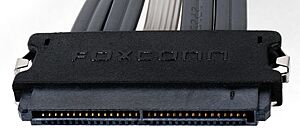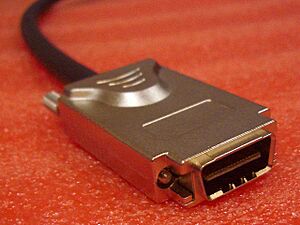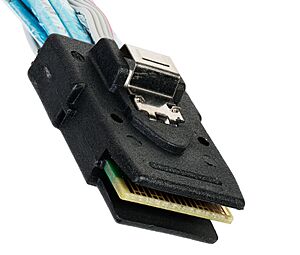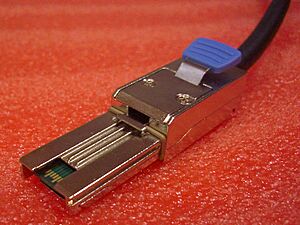Serial Attached SCSI facts for kids
Serial Attached SCSI (SAS) is a special way for computers to talk to storage devices like hard drives and tape drives. Think of it as a super-fast digital highway that moves information back and forth. It's a newer, more modern version of an older technology called parallel SCSI, which was first used in the 1980s.
SAS uses the same basic commands as the older SCSI system, but it sends data one bit at a time, like a single lane on a highway, instead of many bits at once, like a wide road. This "serial" method helps avoid traffic jams and allows for much faster speeds. At first, SAS was a bit slower than the fastest parallel SCSI, but it quickly became much faster. SAS is also designed to work with newer SATA drives, which are common in many computers. This means you can connect SATA drives to a SAS system, but you can't connect SAS drives to a SATA system.
The rules for how SAS works are created and looked after by a group called the T10 technical committee, which is part of the International Committee for Information Technology Standards (INCITS). Another group, the SCSI Trade Association (SCSITA), helps promote SAS technology.
Contents
How is SAS different from parallel SCSI?
SAS and parallel SCSI both help computers talk to storage, but they do it in different ways. Here are some key differences:
- Direct Connection: With SAS, each device usually has its own direct connection to the computer. This is like having a private road for each car. Parallel SCSI, however, is like a shared road where many devices have to share the same path, which can cause delays.
- No End Problems: SAS doesn't need special "terminators" at the end of its cables, which parallel SCSI often needed. This makes setting up SAS easier.
- Better Timing: SAS avoids a problem called "clock skew," which can happen in parallel SCSI and make data transfer less reliable.
- More Devices: SAS can connect to a huge number of devices, up to 16,384! Parallel SCSI is limited to a much smaller number, usually 8, 16, or 32 devices on one connection.
- Faster Speeds: SAS can transfer data much faster than most parallel SCSI systems. Plus, each SAS connection gets its own high speed, while in parallel SCSI, the speed is shared among all devices on the shared road.
- SATA Friendly: SAS systems are designed to work with SATA devices, making them more flexible.
- Same Language: Both SAS and parallel SCSI use the same basic set of commands to talk to devices.
How is SAS different from SATA?
SAS and SATA are both modern ways to connect storage, but they are used for different purposes.
- Device ID: SATA devices are identified by where they are plugged in. SAS devices have a special "World Wide Name" (WWN), like a unique serial number, which helps identify them no matter where they are connected.
- Command Handling: Most SAS drives use something called "Tagged Command Queuing" to handle commands efficiently. Many newer SATA drives use "Native Command Queuing." Both are good, but they work a bit differently.
- Device Types: SATA mainly works with hard drives and CD/DVD drives. In theory, SAS can work with many other devices like scanners and printers, though most of these devices now use other connections like USB or Ethernet.
- Multiple Paths: SAS hardware can connect to devices using multiple paths, which means if one path fails, data can still get through. Most older SATA systems didn't have this feature.
- Market Use: SATA is very common in everyday computers and for general use because it's less expensive. SAS is more expensive and is mainly used in important server systems where reliability and speed are critical.
- Error Checking: SAS has more advanced ways to find and report errors using its SCSI commands compared to the simpler "SMART" commands used by SATA drives.
- Signal Strength: SAS uses stronger electrical signals than SATA. This allows SAS cables to be much longer, up to 8 meters (25 feet), while SATA cables are limited to about 1 meter (3 feet). This stronger signal is helpful for server systems that have many drives in a large case.
Connectors for SAS Devices
SAS connectors are much smaller than the old parallel SCSI connectors. This smaller size allows for smaller hard drives, like the 2.5-inch ones often found in laptops. SAS started with speeds up to 3 Gbit/s and has become much faster over time.
There are several types of physical SAS connectors:
| Image | Codename | What it's also called | Internal or External | How many devices | What it's used for |
|---|---|---|---|---|---|
| SFF 8482 | SATA connector | Internal | 1 | This connector looks like a SATA connector, which means you can plug SATA drives into a SAS system. However, you can't plug SAS drives into a SATA system because their connectors are shaped differently to prevent mistakes. | |
| SFF 8484 | Internal | 4 (or 2) | This is a high-density connector used inside computers. It can connect 2 or 4 devices. | ||
| SFF 8485 | This is an extension of the SFF 8484 connector. It's used for special signals, like those that control LED lights on drive trays. | ||||
| SFF 8470 | Infiniband connector | External | 4 | This is a high-density connector used for external connections, but it can also be used inside. | |
| SFF 8087 | Internal mini-SAS | Internal | 4 | This is a smaller internal connector that can connect 4 devices and is designed for future faster speeds. | |
| SFF 8088 | External mini-SAS | External | 4 | This is a smaller external connector that can connect 4 devices and is also designed for future faster speeds. |
Images for kids
See also
 In Spanish: Serial Attached SCSI para niños
In Spanish: Serial Attached SCSI para niños







